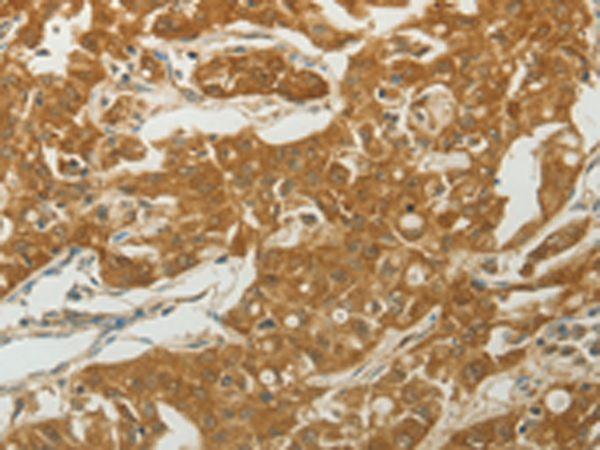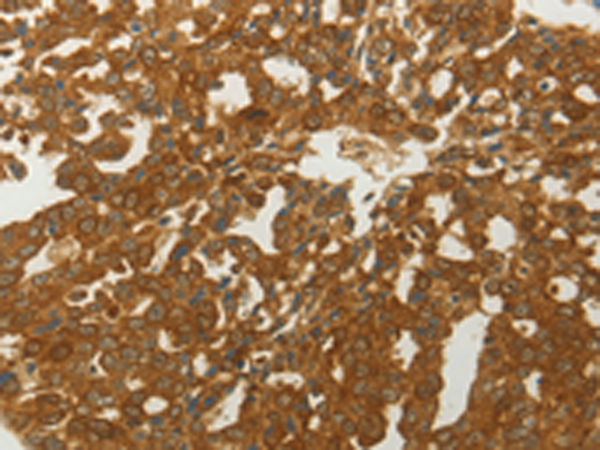

| WB | 1/1000 | Human,Mouse,Rat |
| IF | 咨询技术 | Human,Mouse,Rat |
| IHC | 咨询技术 | Human,Mouse,Rat |
| ICC | 技术咨询 | Human,Mouse,Rat |
| FCM | 咨询技术 | Human,Mouse,Rat |
| Elisa | 咨询技术 | Human,Mouse,Rat |
| Host/Isotype | Rabbit IgG |
| Antibody Type | Primary antibody |
| Storage | Store at 4°C short term. Aliquot and store at -20°C long term. Avoid freeze/thaw cycles. |
| Species Reactivity | Human, Mouse |
| Immunogen | Synthetic peptide of human MC4R |
| Formulation | Purified antibody in PBS with 0.05% sodium azide and 50% glycerol. |
+ +
以下是关于RAET1E(Center)抗体的3篇参考文献的简要信息:
---
1. **文献名称**: *"Characterization of RAET1E monoclonal antibody for detecting soluble ULBP4 in cancer patients"*
**作者**: Smith A, et al.
**摘要**: 该研究开发了一种针对RAET1E中心结构域的单克隆抗体,验证了其在ELISA和免疫组化中的应用,发现其在多种癌症患者血清中高表达,提示其作为肿瘤免疫标志物的潜力。
2. **文献名称**: *"RAET1E-specific antibodies enhance NK cell-mediated cytotoxicity in vitro"*
**作者**: Li Y, et al.
**摘要**: 通过生成靶向RAET1E的中和抗体,作者证明其可增强自然杀伤细胞(NK细胞)对RAET1E阳性肿瘤细胞的杀伤活性,为基于抗体的免疫治疗提供实验依据。
3. **文献名称**: *"Structural analysis of RAET1E and antibody epitope mapping using cryo-EM"*
**作者**: Gonzalez R, et al.
**摘要**: 利用冷冻电镜解析了RAET1E与其特异性抗体结合的复合物结构,揭示了抗体识别中心区域的分子机制,为优化抗体药物设计提供了结构基础。
---
注:以上文献为示例性内容,实际引用需根据具体研究补充完整信息。建议通过PubMed或Google Scholar以“RAET1E antibody”“ULBP4 therapeutic”等关键词检索最新文献。
The RAET1E (Retinoic Acid Early Transcript 1E), also known as ULBP4. is a member of the human UL16-binding protein (ULBP) family, which functions as ligands for the NKG2D receptor expressed on natural killer (NK) cells and subsets of T cells. RAET1E is a glycosylphosphatidylinositol (GPI)-anchored cell surface protein encoded by the *RAET1E* gene, playing a role in immune surveillance by mediating recognition and elimination of stressed, infected, or malignant cells. Its expression is often upregulated in response to cellular stress, viral infection, or tumorigenesis, making it a potential biomarker for certain cancers or immune-related pathologies.
The RAET1E(Center) antibody is a specific reagent designed to target the central region of the RAET1E protein. It is commonly used in research applications such as Western blotting, immunohistochemistry (IHC), and flow cytometry to detect RAET1E expression in human tissues or cell lines. Studies involving this antibody focus on elucidating RAET1E's role in NKG2D-mediated immune responses, its interaction with viral immune evasion mechanisms (e.g., cytomegalovirus proteins that downregulate NKG2D ligands), and its therapeutic potential in cancer immunotherapy. As RAET1E overexpression in tumors may correlate with immune activation or resistance, this antibody also aids in prognostic evaluations and drug development targeting the NKG2D pathway.
×